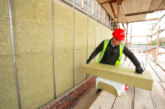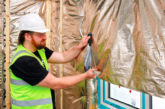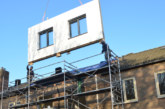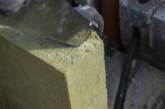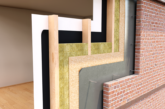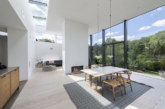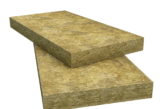
Efficient insulation in buildings no longer simply refers to the specification of thermally-efficient insulation but products that enhance acoustic performance, meet fire safety requirements and are sustainable. PHPD catches up with Isover, which has a long history of providing an extensive range of mineral wool insulation.
Part of the Saint-Gobain group, Isover is renowned for its forward-thinking strategy on product development and sustainability. With its manufacturing plant in Runcorn, the company is well placed to offer a nationwide distribution service for the UK’s housebuilders and developers.
Acoustic performance
With an intense scrutiny on the energy efficiency of homes over the last decade, the focus too, for building insulation has been on its thermal performance. However, as the agenda shifts towards achieving a deeper understanding on how our environment affects our health and wellbeing, Isover has embraced the increasing emphasis being placed on how products can enhance the acoustic performance of homes.
In 2017 Isover launched The Sound Good Factor, a campaign designed to promote the importance of incorporating acoustic solutions within properties to help create great living spaces and improve daily life.
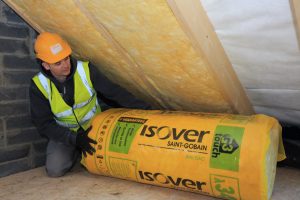
In England and Wales, acoustic performance is covered by Approved Document Part E of the Building Regulations, which stipulates the minimum standards for sound reduction in homes. However, there is a tendency to use this minimum performance as a target performance. Housebuilders and developers should look to exceed these standards in order to create future-proof homes for the ever-growing population – and it’s easy to do so. Isover has a range of acoustic solutions for separating walls, separating floors, internal walls and internal floors which have been designed to surpass the Building Regulations.
Exceeding standards
The minimum requirement for a separating wall in a new dwelling in England and Wales is to reduce airborne sound by 45dB (DnT,W+Ctr). Building to any of Isover’s tried and tested proprietary Robust Details (e.g. E-WM-17, E-WM-20 or E-WM-24) will achieve airborne sound reduction of at least 50dB, which represents a significant improvement beyond the Building Regulations and will have a positive impact on the acoustic comfort of residents.
Glass mineral wool insulation is often viewed as a material that solely affects the thermal performance of a property. However, it can help to improve the acoustics of a building significantly thanks to its structure, which allows it to absorb sound and drastically reduce the transfer of noise.
For example, Isover’s Acoustic Partition Roll (APR 1200) plays a major role in reducing the transmission of airborne sound from one room to another and features in internal wall systems that offer acoustic performance of up to 70dB (Rw). When used within internal floors, it will also significantly dampen noise transference, ensuring comfort for occupants on different levels.
Digital tools
To assist with specification and designed to give housebuilders a competitive edge, Isover has developed some tools for housebuilders when it comes to planning for acoustic insulation. Launched last year, the company’s dedicated online information hub offers insight, resources and advice on using the company’s high-performance acoustic insulation products.
The online tool, dBstation, allows housebuilders and specifiers to choose the most suitable acoustic insulation for their projects. The mobile-friendly application gives users the ability to hear as well as see the difference in noise transference delivered by different types of insulation and partition wall solutions.
In addition, iSelector, the company’s new iPhone app has also been launched to make the specification process for projects simpler. There is also the possibility of downloading technical information and tools such as BIM files via its web-portal, iHub.
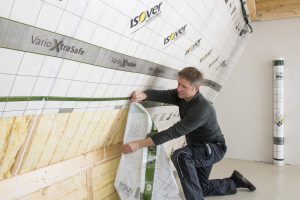
Product development
In 2016, Isover commissioned a research programme investigating the pitched roof rafter-level insulation market. The results of the research highlighted a number of issues, which led Isover to design and manufacture a new pitched roof range for the housebuilding sector.
The feedback from installers was that they were experiencing problems with installing rigid foam boards into rafters; they found it difficult to cut the boards accurately to fit within them without any gaps, and that rigid foam boards also generated a lot of waste. There were also concerns about the use of low-density mineral wool rolls and how some of these products ‘slumped’ when installed into the rafters.
As a result, Isover developed Metac: a high performance glass mineral wool ‘slab on a roll’ that provides a thermal conductivity of 0.034W/mK and possesses impressive acoustic properties to reduce unwanted noise from outside elements. Available in 50 to 200mm thicknesses, Metac has been designed to suit an array of rafter depths and rafter centres and provides an A1 Euroclass fire rating.
Isover’s Stuart Dumbarton, Head of Product Management, commented: “There are many benefits to installing Metac within the rafter zone of a pitched roof. Firstly, it is a very cost effective solution compared to other materials available on the market. It’s also quick and easy to install as it’s lightweight and can be friction-fitted easily between the rafters when cut accurately.
“Accurately friction-fitting the insulation will also result in no slumping or air gaps and also means that the amount of waste will be reduced significantly.”
Improved build quality
Many UK properties have become better insulated and as such, airtightness and moisture management has risen as a market-wide area of concern. If managed incorrectly, moisture build-up within the building’s structure can give rise to a host of problems that will affect the day-to-day comfort levels of the occupants, and could also eventually damage the structure.
For this reason, a smart vapour control layer (VCL) should be specified. Vario XtraSafe from Isover reacts to changes within the internal environment, allowing the membrane to permit trapped moisture to escape from the structure in summer, whilst preventing moisture accumulation within the structure over the winter months.
The Vario XtraSafe system has been designed with speed of construction in mind. Its unique adhesive ‘hook and loop’ system means that a single installer can effectively attach the membrane to the fabric of the building quickly, easily and without waste. The membrane itself is semi-transparent to help with the placement and is pre-printed with 100mm squares to further boost the speed of installation.
Isover is working with its customers continually to understand their requirements, propelling product innovation and customer service forward to ensure housebuilders deliver even better homes.

